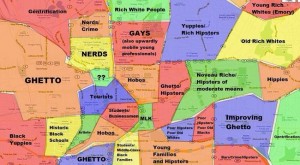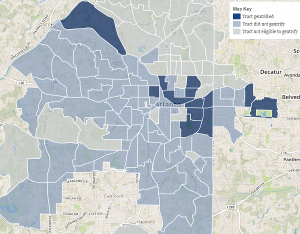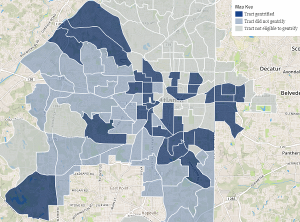Annotated Bibliographies 4-6
Annotated Bibliography #4
Bracey , Trayon . “The Big Discussion with Gentrification in Atlanta .” The Lifestyle Room . 20 Jan 2016. Web. 24 Feb 2016. <http://artrevmagazine.weebly.com/lifestyle/the-big-discussion-with-gentrification-in-atlanta.
The Big Discussion with Gentrification is a topic discussed with Travon Bracey published by The Atriv Magazine in the Lifestyle section. This article discusses His personal experiences of living in Atlanta and how gentrification has affected him and black culture as a whole in terms of socially, financially, politically, mentally and also educationally.
He discusses his experiences in the East Lake neighborhood as a child growing up, he reflects back on his memories of living in these neighborhoods and all the good memories he once shared there, with the people, the inspiring graffiti walled art,(what we may think is gang related), just everything in the environment that creates black culture. He discusses the differences in the community from then to now. He makes a lot of valid points in my opinon…
This article goes to show that even though Tom Cousins and other investors who helped clean up the neighborhood, bringing about a change, completely transforming the neighborhoods, may have very well did everything that they did with GREAT intentions for us all, but not everyone sees it that way and Travon is just one of those people who decided to speak on his views on how gentrification erased the historical and sentimental meaning of the black culture in those neighborhoods, by mixing them or completely taking them over making them unrecognizable to what some used to call home.
This article was an insightful, just to be able to read another side of a story of someone who views the former East Lake neighborhood as something more than a drug filled, crime raised, dead cop zone.
Annotated Bibliography #5
“PBS Newshour.” Chasing the Dream: Poverty and Opportunity in America. PBS, 09 May 2015. Web. 22 Feb 2016. http://www.pbs.org/newshour/bb/can-u-s-break-clusters-poverty-roiling-south/.
Chasing the Dream: Poverty and Opportunity in America is described as a multi-platform public media initiative that provides a deeper understanding of the impact of poverty on American society. This article, which I saw as the complete opposite of “The Big Discussion of Gentrification of Atlanta by Travon Bracey.
This platform allows Jimmy Williams, who after prison dedicated his life to improving poverty driven neighborhoods, to tell his story on how he was caught up dealing drugs in the East Lake community. He describes the toughness of the town and the difficulties to succeed and how he succumbed to the streets and dealing drugs, which landed him seven years in prison and also gave him what he needed to be who he is today, to be able to help those who was once in his position and to prevent others from being there.
This platform speaks of positivity about the transformation. Through research you’ll see that there are several sides to how gentrification has affected its people who live and have lived in these neighborhoods. This article just shows that everything that Tom Cousins and the foundation, Purpose Built Communities, set out to do to improve not just the neighborhood but the community surrounded by them, did in many ways have a great impact on many people.
Annotated Bibliography #6
Felton, Carly. “Atlanta Intown .” Transformation of East Lake.Springs Publishing LLC, 01 Aug 2009. Web. 20 Feb 2016. <http://www.atlantaintownpaper.com/2009/08/the-transformation-of-east-lake/>.
The Transformation at East Lake is an article published by Carly Felting, who discusses the stats that made East Lake neighborhoods such a poverty crazed and criminalized place to live in. it gives a great visual as to why, when and how to why Tom Cousins decided to embark on the journey to transforming East Lake Atlanta’s neighborhoods, these neighborhoods that were once filled with drug dealers and lords, Tom had a vision and though it is was quite risky, it was the greatest endeavor yet. This article would we great for research because it puts numbers into the equations for greater understanding as to how rough and tough these neighborhoods were before the transformation. There are also statements provided from those who were born and raised, or those who did the raising of their children there, stating that being born and subjected to this neighborhood, they never had a chance.
The article discusses the restoration of the golf course, building of new homes, and the transformation of the community, it is very detailed with numbers and it ends with stats showing the outcome of Tom Cousins attempt to making it greater, it shows in numbers the percentage of children and families who now have a chance.



